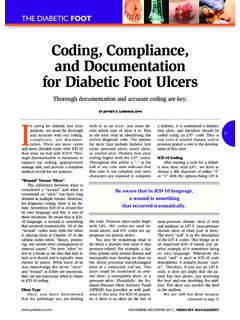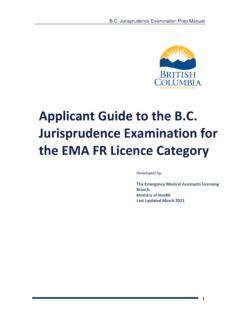Transcription of Gunshot Wounds: Principles and Treatment
1 2016 | PODIATRY MANAGEMENT 149ity is generally seen in civilian popu-lations (Figure 1). A small entrance wound and a large explosive exit wound is indic-ative of a high velocity projectile fired at close range. A small entrance wound with a small or no exit wound with the missile retained within the host s tissue generally is indicative Civilian injuries due to fire-arms are increasing in the United , 2 As podiat-ric surgeons become more involved with trauma, it is important to understand the prin-ciples and types of Gunshot wounds we are faced with every day. Gun-shot wound damage varies with the type of weapon and caliber of the ammunition as well as the distance a missile is shot from.
2 Low Versus High Velocity Gunshot Wounds Gunshots are classified as high velocity, low velocity, high energy low velocity shotgun and low energy low velocity gunshots. High velocity is seen in the military, and low veloc- Welcome to Podiatry Management s CME Instructional program. Our journal has been approved as a sponsor of Con-tinuing Medical Education by the Council on Podiatric Medical Education. You may enroll: 1) on a per issue basis (at $ per topic) or 2) per year, for the special rate of $210 (you save $50). You may submit the answer sheet, along with the other information requested, via mail, fax, or phone. You can also take this and other exams on the Internet at If you correctly answer seventy (70%) of the questions correctly, you will receive a certificate attesting to your earned credits.
3 You will also receive a record of any incorrectly answered questions. If you score less than 70%, you can retake the test at no additional cost. A list of states currently honoring CPME approved credits is listed on pg. 156. Other than those entities currently accepting CPME-approved credit, Podiatry Management cannot guarantee that these CME credits will be acceptable by any state licensing agency, hospital, managed care organization or other entity. PM will, however, use its best efforts to ensure the widest acceptance of this program possible. This instructional CME program is designed to supplement, NOT replace, existing CME seminars. The goal of this program is to advance the knowledge of practicing podiatrists.
4 We will endeavor to publish high quality manu-scripts by noted authors and researchers. If you have any questions or comments about this program, you can write or call us at: Podiatry Management, Box 490, East Islip, NY 11730, (631) 563-1604 or e-mail us at Following this article, an answer sheet and full set of instructions are provided (pg. 156). EditorContinued on page 150 Continuing Medical educationcontinuingMedical educationEducational Goals: After completion of this CME, the reader will: 1) Understand the differences between low and high velocity Gunshot wounds. 2) Gain information on Treatment of gun-shot wounds. 3) Understand the Gustilo classification of compound s an in-depth look at these traumatic RitchaRd Rosen, dPMGunshot Wounds: Principles and Treatmentnerves, skin, and subcutaneous fat.
5 Although each structure is evaluated, the close proximity of all these struc-tures in the foot requires knowledge of anatomy as well as function of each of the above. When confronting a Gunshot wound, the following protocol should be followed: 1) Take an adequate history. It is important to ascertain if a flash bleed has occurred. Flash bleed is rapid blood loss at the time of the injury. 2) Check vital signs. 3) Inspect for burns to the tissue, swelling, and pallor. These must be noted. Entrance and exit wounds must be identified. If, however, there is no exit wound, imaging must be utilized to identify the location of the bullet.
6 4) Physical exam. Examination by system must be performed (vascu-lar, neurologic and musculoskeletal). Bone By definition, a Gunshot fracture is a high energy open fracture. Sev-of a low velocity bullet speed less than 2000 (Figures 2,3).3 In evaluating and treating Gunshot wounds, the extent of the tissue damage caused by the bullet is of utmost importance. The local effects of missile injuries are: 1) Laceration and crushing 2) Production of shockwave and tem-porary cavitation Laceration and crushing are the principle effects of the bullet passing through the tissue planes and causing damage primarily to the permanent cavity region of the bullet Temporary cavitation is more of a concern with high velocity wounds.
7 As the missile penetrates the tissue planes, an extension of injury occurs and expands the damage and size of the track greater than the size of the missile. The temporary track can cause damage at distances remote to the original clinically observed , 4, 9 Most Gunshot wounds encoun-tered in private practice involve low velocity projectiles, and therefore the amount of tissue damage encoun-tered as well as the amount of con-tamination is much less than with the military injury (Figure 4).5 The shotgun is another type of in-jury encountered in private practice. Tissue damage is dependent on the range at which the shotgun is Fired at point blank range (less than 15 yards), the shotgun pellets are extremely lethal, and produce an extensive wound with sub-stantial bone and soft tissue loss with comminution and damage to the neurovascular structures (Figures 5,6).
8 4, 6, 8, 9 Fired at long range, shot-gun velocity diminishes and the pellets disperse as they reach their target. Subsequent-ly, long range shotgun pellets cause minimal damage, and experience has shown that these wounds sustained are of little sequella to the patient (Figure 7). Management of Gunshot Wounds When encountering Gunshot wounds to the lower extremity, one must evaluate bones and joints, mus-cle, tendon units, vascular structures, 2016 | PODIATRY MANAGEMENT 150continuingMedical educationcMeGunshot Wounds (from page 149)Continued on page 151 Laceration and crushing are Principles of Low velocity 5: shotgun , close rangeFigure 2: Low velocity gSWFigure 3: High velocity gSWFigure 4: Low velocity from distanceFigure 1: High velocity Gunshot woundfollowed by copious irriga-tion and early fixation of the fracture (Figure 9, 10).
9 Berg, et al. in their study iden-tified that one-fifth of the fractures were treated by debridement only without hardware fixation. These were fractures that are inherently stable or do not require sta-bilization ( , fib-ula). Only 8% of the fractures were treated with open reduction and inter-nal These numbers agree with the report by Weil and As reported before, in 8 of the 12 fractures treated with prima-ry external fixators, this was the definitive Treatment for union. This high percentage emphasizes the comminuted nature of the Gunshot fracture, type, and the tendency to prefer a biological splint fixation, maintaining a fracture-healing envi-ronment.
10 Skin Soft Tissue Ordog, et retrospectively reviewed 28,150 patients with gun-shot wounds; 60% of them were treated as outpatients. Four per-cent had minor fractures not re-quiring operative stabilization. The patients were treated with local wound debridement, irrigation, and an antibiotic ointment. Only had wound infections that respond-ed well to oral antibiotics without requiring hospital admission. In their study of 163 patients with ci-vilian Gunshot wounds, Brunner and Fallon19 found no differences between patients who had debride-ment and wound care and patients who had local wound care alone.











